Enhancing Spaces with Narrow Pergolas: A Design Guide
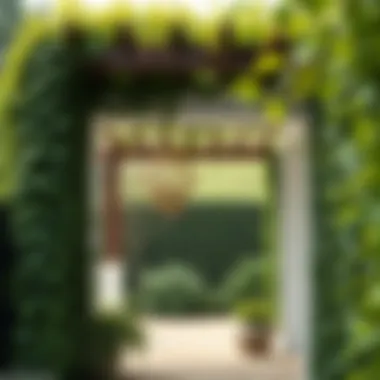
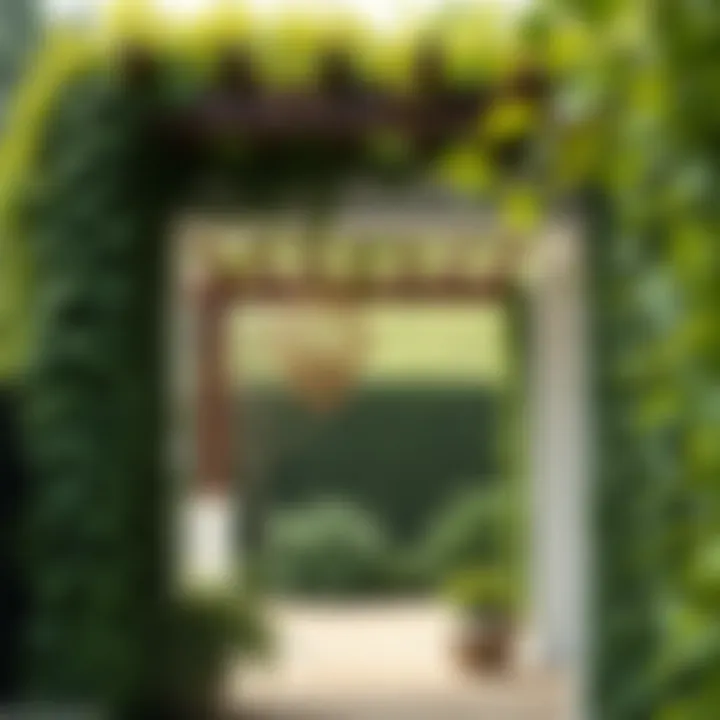
Intro
Narrow pergolas are becoming a popular choice in contemporary outdoor and indoor designs. Their unique structure allows for versatility in both functionality and aesthetics. Whether you're looking to create a serene space in your garden or add depth to your living area, these structures can be a transformative element. Often overlooked, narrow pergolas are practical, enabling various uses from shade to support for climbing plants, while also bringing an undeniable charm to a space.
Understanding the components of narrow pergolas can be a game changer. They can serve multiple purposes, including creating a designated area for relaxation, enhancing privacy, or even acting as a visual pathway. This guide aims to peel back the layers on narrow pergolas, offering insights on design inspiration, gardening advice, and practical applications to better equip homeowners, interior design enthusiasts, and garden aficionados for their projects.
Design Inspiration
Trending Styles and Themes
When it comes to designing narrow pergolas, the styles can vary tremendously. From rustic wooden frames exuding a natural feel, to sleek metal structures that scream modern elegance, one is spoiled for choice. The design theme you lean towards can greatly influence the overall ambiance of your space.
- Traditional: Incorporating wood and classic shapes, this style often features intricate details and is perfect for gardens or patios seeking a timeless look.
- Modern Minimalist: Simple lines and materials such as aluminum or powder-coated steel can make for structures that seamlessly blend with contemporary homes, offering an airy feeling.
- Bohemian: For those who appreciate a bit of whimsy in their design, adding colorful fabrics, mixed materials, or even hanging decorations can create a playful yet stylish atmosphere.
This diversity in styles provides ample room for creativity. As trends shift, the integration of biophilic designs—where elements of nature are woven into the architecture—has gained traction. More homeowners are experimenting with plants that will trail and intertwine with the structure, embracing the natural world within their living spaces.
Color Palettes and Combinations
Selecting the right colors can breathe life into your narrow pergola. Certain palettes can enhance your garden's appearance or create a stunning focal point inside a room.
- Earth Tones: Shades like warm browns, soft greens, and muted yellows ground the pergola in nature and create a cohesive look with garden elements.
- Bold Colors: Using striking colors such as cobalt blue or vivid orange can turn ordinary pergolas into eye-catching pieces of art. The contrast with greenery can be particularly striking.
- Monochromatic Schemes: Sticking to a single color but varying the shades gives depth without overwhelming the eye.
It's wise to consider the surroundings when choosing a color palette. For instance, a dark hue might absorb heat, providing more shade, while lighter tones may help reflect sunlight effectively.
Gardening Advice
Seasonal Planting Guides
A narrow pergola can be an ideal support for various climbing plants, and knowing the right season to plant makes all the difference. Some plants thrive under these structures, creating natural canopies and lovely visuals.
- Spring: Now's the time to plant climbing roses or clematis. These bloom beautifully in spring and can create a fantastic aesthetic.
- Summer: Vines like morning glories thrive during summer months, adding vivid colors as their blossoms open under the sun.
- Autumn: Opt for plants like ornamental gourds or squash, which can add a rustic touch as the weather cools down.
Maintenance and Care Tips
Managing a narrow pergola and its plants doesn’t have to be daunting. Here are some care tips to consider:
- Regular pruning of climbing plants ensures they don’t overwhelm the structure, encouraging growth in the right areas.
- Check for any signs of wear or damage on the pergola, especially in changing weather. Regular inspections help keep everything in tip-top shape.
- Watering is key; make sure to follow the needs of your plants, especially during the hotter months.
By adhering to these guidelines, you’ll be setting yourself up for a stunning outdoor or indoor space that embodies both style and functionality.
"A well-placed narrow pergola can transform a bland corner into a captivating visual storytelling space where nature and design merge beautifully."
For more resources on gardening and design, you may find these links helpful:
With the right design approaches and planting strategies, narrow pergolas can truly enhance your space, making them a worthy investment in your home and garden.
Prolusion to Narrow Pergolas
As we embark on this exploration of narrow pergolas, it’s vital to grasp the essence of what these structures bring to both outdoor and indoor environments. Narrow pergolas, often seen gracing backyards and gardens, extend beyond mere aesthetics; they serve as intimate spaces that can transform a drab area into a vibrant retreat. With their elongated frames and open lattices, these structures cultivate a sense of shelter while allowing for natural light to filter through, creating a subtle interplay between shade and sun.
The Importance of Narrow Pergolas
Narrow pergolas play a pivotal role in enhancing the charm of outdoor gardens and backyards. Their narrow design allows them to fit into spaces that might otherwise feel cramped or underutilized. Moreover, they provide vertical elements that draw the eye upwards, making even the smallest area feel more expansive. This important feature is particularly beneficial in urban settings where outdoor spaces come at a premium.
When considering functionality, narrow pergolas also excel. They can frame pathways or central seating areas, guiding visitors through a garden while providing a focal point that invites relaxation. By integrating plants such as climbing vines or colorful blossoms, they become living, breathing installations that change with the seasons, adding depth and texture to any space.
Benefits of Incorporating Narrow Pergolas
- Space Efficiency: Their slender profile allows narrow pergolas to occupy limited spaces, making them ideal for patios, balconies, or alongside walkways.
- Temperature Control: They help regulate sunlight, protecting seating areas from scorching rays during the height of summer while still allowing warmth during the cooler months.
- Aesthetic Appeal: The visual aspect is considerable; they can serve as beautiful backdrops for outdoor gatherings or family BBQs.
- Versatility: These structures can be crafted from various materials—including wood, metal, or vinyl—offering homeowners the chance to align their choice with personal style and local design ethos.
Considerations in Design and Use
It’s essential to approach the design of a narrow pergola with intent. Consider the orientation of the sun, the position of the surrounding structures, and how it will integrate with the existing landscape. A carefully planned pergola can truly enhance the experience of a space, making it inviting yet functional.
As we proceed through this guide, we will delve into defining narrow pergolas in detail, exploring their materials, styles, benefits, and practical applications. For those looking to create defined spaces or enhance outdoor comfort, understanding the nuances of narrow pergolas becomes indispensable. They are not just additions to a home; they are an embodiment of thoughtful design tailored to elevate everyday life.
Defining Narrow Pergolas
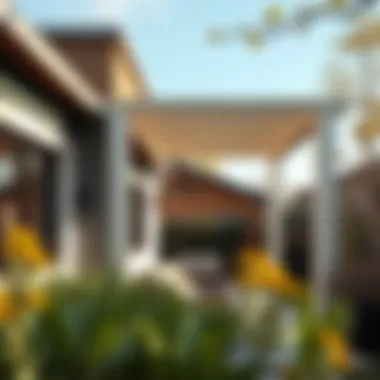
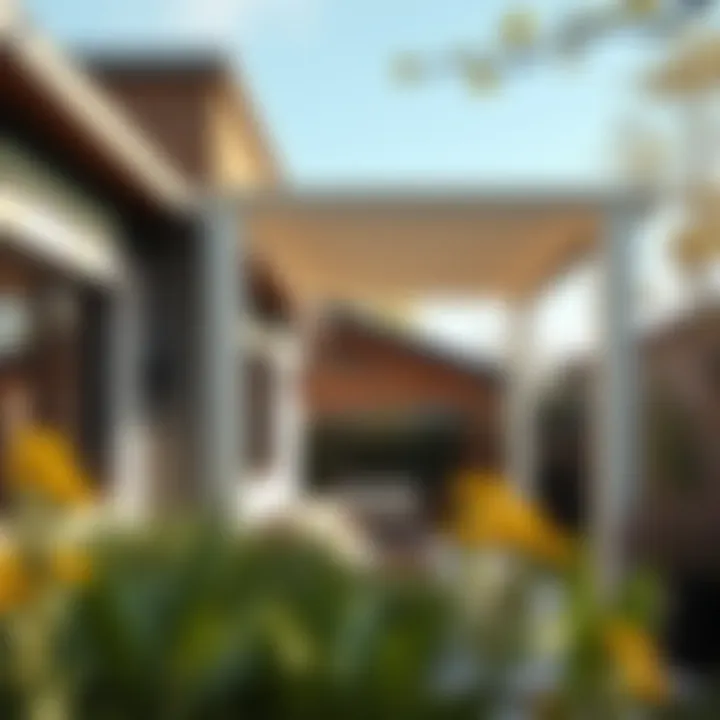
In the quest to enhance outdoor living spaces, narrow pergolas often emerge as an integral element. These structures bridge indoor and outdoor environments, allowing homeowners to redefine their space while adding charm and functionality. Understanding what exactly constitutes a narrow pergola is crucial for their effective integration into various settings, whether in a sprawling backyard or a modest urban garden. This section examines the intricacies of narrow pergolas, underscoring their role, benefits, and design considerations.
Understanding Size Specifications
Narrow pergolas are typically distinguished by their dimensions, which contribute significantly to their functionality and aesthetic appeal. Generally speaking, a narrow pergola can range from about five feet wide to about eight feet wide, each size lending itself to different applications and settings. This sizing plays a crucial role in both spatial definitions and the desired ambience of an area. When considering a narrow pergola, it is prudent to think about the following aspects:
- Proportionality: The size should harmonize with existing structures and landscapes. A narrow structure that is too imposing can disrupt visual flow.
- Height Matters: The height of a pergola can influence the experience of the space. Commonly, they sit between seven to ten feet tall, allowing for headroom while creating an intimate atmosphere.
- Functionality: Consider how the size will affect the intended use. For example, a narrow pergola might be ideal for a walking path or a seating area, but a more substantial structure may be needed for outdoor dining or parties.
The dimensions directly affect how the pergola fits within the microcosm of your outdoor setup. Take careful measurements of the desired area before making any decisions.
Materials Commonly Used
The choice of materials for constructing narrow pergolas can greatly influence both their longevity and visual impact. Homeowners have several options, each suited to different styles and climates. Here’s a look at some popular materials:
- Wood: Timeless and versatile, wood adds warmth to any space. Cedar and redwood are common choices, as they resist decay and insects well. A wooden pergola can blend seamlessly into natural surroundings, making it a favorite for gardens.
- Vinyl: For low-maintenance options, vinyl offers durability and an array of colors. Unlike wood, it won’t warp or splinter, making it ideal for homeowners who prioritize ease of care.
- Metal: Aluminum and steel are becoming increasingly popular for a modern look. Metal structures can be sleek and lightweight while ensuring sturdiness, making them suitable for urban environments where wind load is a consideration.
- Composite Materials: These blends of wood fibers and synthetic materials provide the appearance of wood while minimizing upkeep. They’re resistant to rotting and often have a long lifespan.
"The material selection goes beyond aesthetic appeal; it influences durability and maintenance requirements of your narrow pergola."
Ultimately, the choice of material should balance visual aesthetic with practical considerations, aligned with local climate conditions and stylistic preferences.
Design Considerations
Design considerations play a vital role in the successful integration of narrow pergolas into any landscape or architectural project. It is not just about aesthetics; it encompasses functionality and utility as well. When planning a narrow pergola, it’s essential to contemplate how it will complement the environment, serve its purpose effectively, and ultimately elevate the space. With proper design, a narrow pergola can forge a seamless transition between the built environment and the natural world, creating an inviting sanctuary.
Visual Aesthetics
The visual aesthetics of a narrow pergola can transform an ordinary outdoor area into an enchanting retreat. The way a pergola is designed will dictate not only its appearance but also the atmosphere it creates. The frame's shape, the spacing between rafters, and even the size of posts contribute to the overall look. For example, using a trellis pattern on a narrow pergola allows for climbing plants to weave through, promoting an organic feel that blends with nature.
Moreover, different architectural styles can inspire varying designs. A sleek, modern pergola with sharp lines may be the right fit for urban settings or contemporary homes, while a rustic wooden pergola might align perfectly with a country-style estate. This diversity captures different tastes and enhances the visual component of the space.
"A well-designed pergola doesn’t just add structure; it brings visual harmony to the entire landscape."
Integration with Existing Architecture
Integrating a narrow pergola with the existing architecture can profoundly impact the overall cohesiveness of a property. It is crucial to consider how the design interacts with adjoining structures—spacing, alignment, and even character matters. The pergola should reflect the homeowner’s architectural style while also fitting harmoniously within the layout.
For instance, in homes with a traditional design, the posts of the narrow pergola could be crafted from wood with ornamental detailing to mirror similar features in the home. Conversely, minimalistic metal frames work wonders for modern home designs. Also, consider the synergy between the pergola and its surroundings; it should enhance sightlines rather than obstruct them, creating an open feeling that invites exploration.
Color and Finish Options
The color and finish of a narrow pergola are vital in crafting its final look. Whether you prefer a natural wood look or a bold painted finish, the choices are diverse. A natural finish allows the grain of the wood to shine through, creating warmth and a rustic charm. Alternatively, opting for a vibrant paint color can inject personality, making the structure a focal point.
It's essential to think about longevity as well. High-quality finishes not only elevate aesthetics but also protect the materials from the elements. For example, weather-resistant stains and paints can help prevent wear over time, ensuring your pergola remains a stunning asset for years to come.
When choosing color, one should also consider the surrounding landscape. Colors that harmonize with nearby flowers, plants, or walls can help the pergola blend beautifully into the environment, providing coherence and enhancing the overall aesthetic appeal.
By engaging thoughtfully with these design considerations, homeowners and designers alike can maximize the potential of narrow pergolas, making them not just structures, but landmarks of beauty and utility.
Functional Benefits
When it comes to enhancing outdoor and indoor spaces, narrow pergolas stand out as an excellent choice. These structures provide functional benefits that go beyond mere aesthetics. They are versatile and can significantly improve the usability of various areas, catering to the needs of homeowners, gardening enthusiasts, and anyone looking to create inviting spaces.
Creating Defined Spaces
Narrow pergolas are like invisible walls that don't close off spaces but create ambiance instead. They can help delineate areas within a larger outdoor setting, giving clear boundaries without sacrificing openness. For instance, in a sprawling garden, a narrow pergola can neatly mark a seating area or a pathway, making it feel purposeful and designed.
An ideal example can be a backyard barbecue zone. By placing a narrow pergola over the grill and picnic table, you can define that space for eating and cooking, distinguishing it from nearby flower beds or children's play areas. This adds both functionality and an element of style.
Moreover, a narrow pergola can serve to accentuate an entrance or walkway. Think of it as a guidepost that invites guests to explore your garden further, creating a sense of intrigue. You can also hang lights or plants from the beams, enhancing this defined area with visual appeal that draws the eye.
Enhancing Outdoor Comfort
Comfort is key when designing outdoor spaces, and narrow pergolas excel at this. By providing light shade, they allow the enjoyment of outdoor areas even during the hot summer months. The open slats create a balance of sun and shade that can make lounging around much more enjoyable.
With some thoughtful planning, you can elevate comfort levels further. For example, draping sheer fabrics from the beams can offer additional protection from the sun while creating a cozy nook for reading or relaxing. You might even consider incorporating climbing plants, such as wisteria or honeysuckle, which can provide natural shade and an invigorating fragrance.
"Well-designed outdoor spaces contribute to mental well-being, helping homeowners to unwind and connect with nature.”
— Source: Psychology Today
In addition, narrow pergolas can act as a refuge from light rain or wind, allowing you to host gatherings without fear of sudden weather changes. Adding outdoor furniture beneath a pergola creates a natural gathering space for family and friends, fostering social connection while being shielded from the elements.
In essence, the functional benefits of narrow pergolas are numerous. They not only create defined spaces but also enhance the comfort of your outdoor experience, making them a valuable addition for anyone looking to elevate their property’s potential.
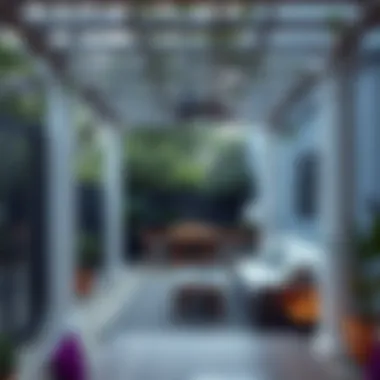
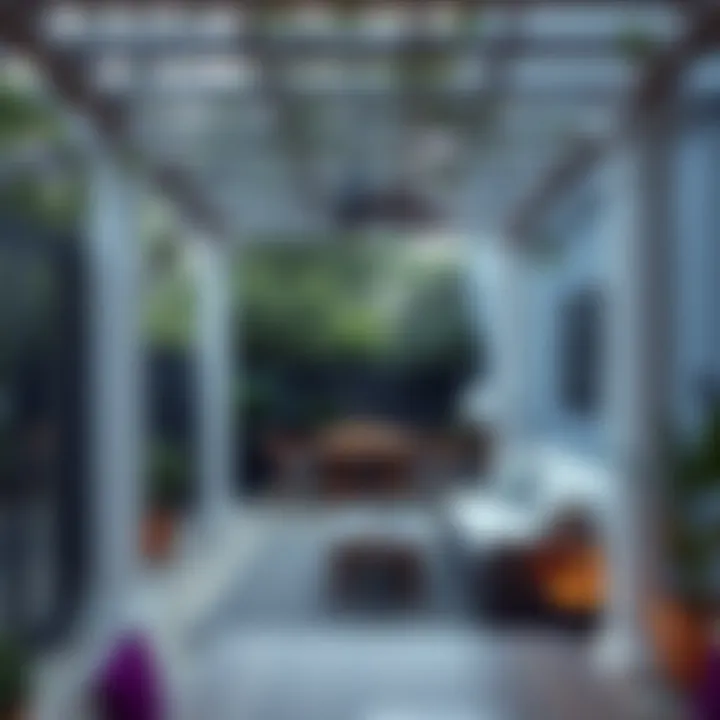
Types of Narrow Pergolas
In the world of outdoor architecture, narrow pergolas stand out not only for their size but also for their versatility. Understanding the types of narrow pergolas is crucial for anyone considering an addition to their outdoor space. Each type comes with distinct characteristics that cater to various aesthetic and functional needs. This section dives into the essential types and their unique benefits, helping homeowners, interior design aficionados, and gardening enthusiasts make informed decisions.
Freestanding Narrow Pergolas
Freestanding narrow pergolas offer a unique flexibility that attached structures might lack. Positioned away from walls or buildings, these pergolas serve as standalone features. Their appeal lies in how they can define space in a garden or a patio. Homeowners often choose them to create intimate gathering spots or to draw the eye to a beautiful view.
Some characteristics that make freestanding narrow pergolas appealing include:
- Versatility in Placement: These structures can be placed almost anywhere in a yard, allowing for customized outdoor areas based on sunlight, landscape, or desired privacy.
- Design Independence: With no structural ties to existing buildings, designers and homeowners can experiment with various styles and materials to suit personal tastes.
- Enhanced Aesthetics: Freestanding pergolas can be adorned with climbing plants, drapes, or lighting, turning them into statement pieces that capture attention.
Attached Narrow Pergolas
Attached narrow pergolas are a different ball game altogether. These structures are built directly onto existing walls or structures, offering seamless integration with homes. Attaching a pergola to a house can effectively extend living spaces outdoors, turning patios and terraces into cozy retreats or entertainment hubs.
Consider some advantages of attached narrow pergolas:
- Space Efficiency: By connecting to the house, they utilize existing architecture, making them ideal for smaller yards where space is at a premium.
- Functional Transition: These pergolas create smooth transitions between indoor and outdoor living, encouraging a natural flow and making outdoor spaces more inviting.
- Protection and Shade: An attached pergola often provides shade from the sun while allowing for improved ventilation, making it practical for dining or lounging.
Custom Designs and Innovations
For those willing to think outside the box, custom designs and innovations present a thrilling avenue. Custom narrow pergolas can be tailored to fit specific dimensions, function, and aesthetic desires, allowing endless possibilities. Some noteworthy aspects include:
- Personalization: From tailored dimensions to unique ornamental features, custom designs offer homeowners a chance to express their individual flair.
- Innovative Materials: Advances in materials, like composite woods or metals, give rise to designs that were once unattainable or impractical. These materials can enhance durability and require less maintenance.
- Smart Technology: Some modern designs incorporate smart features like adjustable roofs or integrated lighting systems, which can be controlled via mobile devices for ultimate convenience and atmosphere.
"Custom narrow pergolas represent the pinnacle of personalization, merging form and function to achieve breathtaking outdoor experiences."
With the right type of narrow pergola, you can transform an ordinary space into an extraordinary outdoor retreat, marrying functionality with stunning aesthetics.
Practical Applications
When one thinks about narrow pergolas, the mind may often wander to the aesthetic appeal or design intricacies of such structures. However, their practical applications cannot be overlooked. These elegant constructions serve not just as visual enhancements to outdoor spaces but also as functional elements that enhance usability, comfort, and overall atmosphere. In various contexts such as home gardens or public spaces, narrow pergolas act as transitional spaces that bridge the gap between nature and built environments, enabling people to enjoy outdoor activities in controlled conditions.
Use in Home Gardens
In residential settings, narrow pergolas become striking focal points in home gardens. They can define spaces, providing areas for relaxation, dining, or even small gatherings. With the right plants creeping over or hanging from it, a narrow pergola transforms into a lush, shaded hideaway that invites people to unwind.
- Creating Outdoor Rooms: A well-placed pergola can serve as an outdoor "room" where families can engage in activities without the intrusions of the outside world.
- Vertical Gardening Opportunity: Homeowners can use the structure to grow popular climbing plants like wisteria or grapevines, promoting vertical gardening, which is particularly beneficial for small spaces.
- Shade and Sun Control: In regions with intense sun exposure, a narrow pergola offers essential shade, allowing for outdoor living spaces to be more comfortable throughout the day. It also provides a natural cue for light, creating an enchanting play of shadows on the garden floor.
Narrow pergolas are about more than just aesthetics; they represent practicality in usage and enjoyment of outdoor spaces. They invite homeowners to get creatively engaged with their gardens, allowing for personal expression through plant choices and décor.
Applications in Public Spaces
Beyond private residences, the presence of narrow pergolas in public spaces plays a vital role in enhancing urban landscapes and recreational areas. These installations are not merely ornamental but serve functional purposes that significantly improve the visitor experience in parks, plazas, and botanical gardens.
- Providing Rest Areas: Public parks often utilize narrow pergolas to create shady spots for families or individuals seeking a break from the sun, thus improving the overall usability of the space.
- Event Hosting Areas: Parks and public gardens can host various activities, including art displays, local markets, or outdoor performances, with narrow pergolas framing the space and providing structural integrity for lighting or decorations.
- Guiding Foot Traffic: A well-placed narrow pergola can help direct foot traffic, enhancing the flow of movement through expansive public areas and ensuring that people linger at key points of interest.
As urban environments evolve, the incorporation of structures like narrow pergolas becomes essential to creating inviting public spaces that cater to community needs and enrich the urban experience. The enduring nature of these structures serves practical aspects while encouraging social interaction.
"The right design in our public spaces not only reflects beauty but also fosters community connection and enhances our quality of life."
In summation, the practical applications of narrow pergolas extend beyond mere decoration. They serve as functional pieces that define space, enhance comfort, and facilitate a vibrant social atmosphere, both in home gardens and public areas.
Maintenance and Care
Caring for your narrow pergola is not just about keeping it looking good; it’s essential for ensuring its longevity and performance. A well-maintained pergola can add charm and functionality to your property, while overlooking proper care can lead to unsightly deterioration and possibly costly repairs. This section dives deep into the two key areas of maintenance: cleaning procedures and preventative care. Understanding these will help you keep your outdoor structure in top shape for many years.
Cleaning Procedures
Cleaning your narrow pergola is a relatively straightforward process that should be conducted regularly to prevent the buildup of dirt, debris, and grime. Here’s how to go about it:
- Frequency: Depending on your location, aim to clean your pergola at least twice a year, with more frequent cleanings in areas with heavy rain or dust.
- Tools Needed: A soft-bristle brush, a bucket, mild detergent, hose or power washer, sponge, and possibly a ladder or extendable brush for taller sections.
- Steps to Clean:
- Start by removing any loose debris, such as leaves or twigs.
- Prepare a cleaning solution by mixing water with a mild detergent. Avoid harsh chemicals that might damage the finish.
- Use the soft-bristle brush to gently scrub the surface of the wood or metal to lift dirt.
- Rinse thoroughly with water from the hose or power washer. Make sure to keep the nozzle at a safe distance to prevent damage.
- Wipe down surfaces with a sponge to remove any remaining residue.
Regular cleaning not only helps preserve the aesthetics of your pergola but also prevents any build-up that could lead to long-term damage.
Preventative Care for Longevity
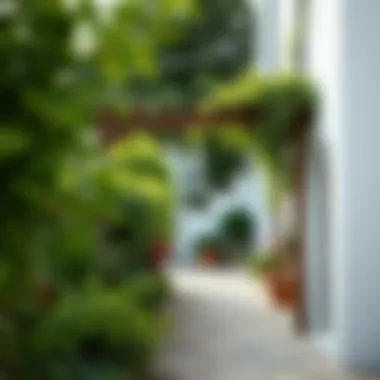
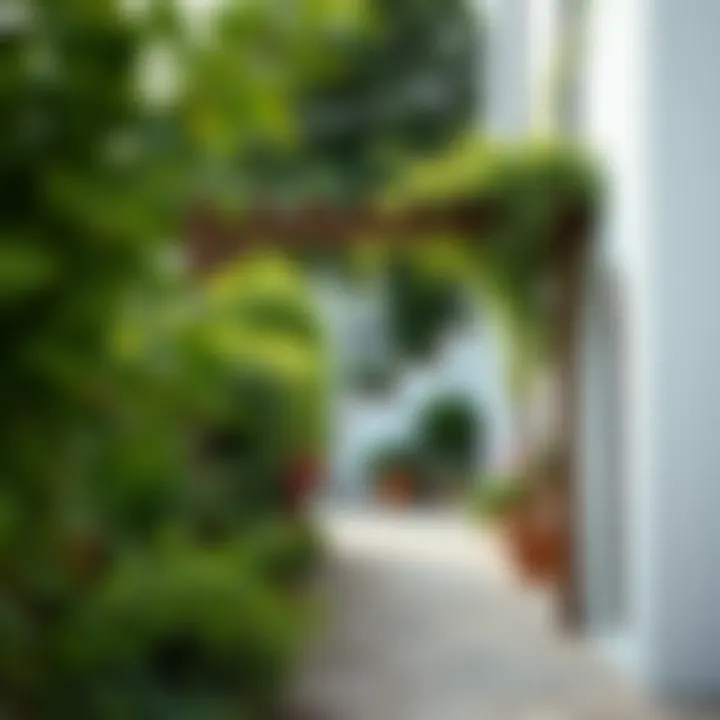
Taking proactive steps can significantly enhance the lifespan of your narrow pergola. Here are some effective strategies:
- Protective Coatings: Apply a protective sealant designed for wood or metal every few years to guard against rot and rust. This can create a barrier against moisture and UV rays, which are the main culprits in wear and tear.
- Inspect Regularly: Regular inspections are vital. Look for signs of damage like cracked wood, rust spots, or loose fittings. Catching these issues early can save you a headache down the line.
- Trimming Vines: If your pergola has climbing plants, make sure to trim them back when needed. Excess weight or foliage can strain the structure and encourage pests.
- Anchor Security: Ensure that all anchorage points are secure and sound. Earthquakes or strong winds can test their integrity, and being proactive avoids nasty surprises during inclement weather.
By incorporating these cleaning and care tips, your narrow pergola will not only look appealing but will also serve as a functional and durable element of your space.
Maintaining your pergola regularly can save you a significant amount on repairs in the long run. Taking time to care means time saved in the future!
For further insights on caring for outdoor structures, you might find resources like Wikipedia or Fine Gardening useful.
Cost Considerations
Cost considerations associated with narrow pergolas play a vital role in the decision-making process for homeowners and designers alike. The investment you put into a pergola can enhance your outdoor space, creating an environment that is both functional and aesthetically pleasing. Understanding the financial aspects helps in accurately assessing what you can expect from your purchase while ensuring that your vision aligns with your budget.
Effective cost management begins with recognizing the different aspects that contribute to the overall price. Considering everything from design and materials to installation processes will equip you with a clearer picture of the funds required. Moreover, being aware of potential hidden expenses helps prevent those pesky surprises down the road.
"Investing in a narrow pergola is not just about the initial outlay; it is a commitment to enhancing your living space for years to come."
Budgeting for Design and Installation
When planning the budget for both design and installation of a narrow pergola, one needs to consider several elements comprehensively. First, the design complexity significantly influences the overall expense. A simple structure typically demands less initial investment, whereas a more elaborate design with customized features could set you back considerably.
Additionally, materials can vary widely. Common choices include:
- Wood: Often favored for its natural look but can be more expensive if opting for premium types like cedar or redwood.
- Metal: Aluminum or steel might be a solid choice for durability. These materials tend to be more cost-effective in the long run but could require a higher upfront cost.
- Composite materials: These are engineered products that can be more affordable while providing the best of both worlds in terms of durability and maintenance ease.
Installation costs should also align with your chosen design and materials. Hiring professionals may add to the expense, yet their expertise can ensure quality and safety. Alternatively, if you're the hands-on type, a DIY project can save significant bucks but will require a hefty investment of time and effort.
Long-term Value Assessments
Evaluating the long-term value of your narrow pergola goes beyond its initial cost; it's about understanding the benefits it brings to your property over time. A well-constructed pergola can increase the overall appeal and potentially raise the property's resale value. Property buyers often appreciate well-designed outdoor spaces, which adds another layer to the investment.
Moreover, considering energy savings is essential. A pergola can provide shade, helping to reduce air conditioning costs during warm seasons. This practical advantage often gets overlooked but holds considerable weight when considering the long-term financial benefits. Additionally, if it's placed thoughtfully, it can enhance the usability of adjacent spaces, allowing for enjoyable experiences in outdoor settings associated with gatherings and leisure activities.
In light of these factors, balancing cost with potential returns becomes imperative. Practical assessments should take into account not just how much you will spend, but how much enjoyment and value this structure will provide over its lifetime.
Innovative Trends
The realm of narrow pergolas is continuously evolving, and staying abreast of innovative trends can significantly enhance both functionality and visual appeal. In this section, we will dive into two crucial aspects of these trends: sustainable materials and modern design elements. The importance of these trends cannot be overstated, as they cater to a growing demand for eco-friendly solutions while ensuring that aesthetics do not take a back seat.
Sustainable Materials and Construction
The emphasis on sustainability has made its mark across various sectors, and the construction of narrow pergolas is no exception. Utilizing sustainable materials not only positively impacts the environment but also adds a unique character to outdoor structures. For instance, bamboo has gained traction as an eco-friendly alternative due to its fast growth and minimal environmental footprint. This versatile material can be crafted into beautiful pergolas that blend seamlessly with nature.
Some other materials to consider:
- Recycled Wood: Repurposed wood helps in reducing deforestation while giving a rustic charm to the pergola.
- Composite Materials: Made from a blend of wood fibers and plastics, these materials are durable and resistant to rot, making them ideal for outdoor use.
- Steel and Aluminum: Lightweight yet strong, these metals can be sourced sustainably and can be designed for modern aesthetics.
When thinking about construction, simple changes like using non-toxic adhesives and paints can make a significant difference. Moreover, the method of installation should also lean towards sustainable practices, like minimizing ground disruption which is essential for landscaping integrity.
"Sustainable designs don't just protect nature; they elevate the spaces we live in, creating harmony between structures and their surroundings."
Modern Design Elements
As we embrace sustainability, the aesthetic aspect should not be overlooked. Modern design elements are where functionality meets style, turning narrow pergolas into visual standouts. Below are several trends that might catch your fancy:
- Geometric Shapes: Sleek lines and angular shapes create a contemporary look that can serve as a striking visual centerpiece.
- Lattice and Canopy Configurations: Combining lattice work with fabric can offer both shade and style, allowing for personalization based on climate and seasonal preferences.
- Integrated Lighting: Smart lighting solutions can enhance evening ambiance while also providing safety and accessibility.
Incorporating these trends addresses the needs of homeowners and designers alike, encouraging the creation of spaces that are not only practical but also inviting. Each element contributes to a narrative of quality and innovation, providing a refreshing take on what a pergola can be in contemporary settings.
In summary, the trends in sustainable materials and modern design elements come together to redefine narrow pergolas, ensuring they are both functional and aesthetically pleasing. As homeowners, this is a chance to align your outdoor designs with modern sensibilities and ecological practices, enhancing your living space while contributing positively to environmental well-being.
Continue exploring these innovative trends to stay ahead in the game of outdoor design!
Ending
In the realm of outdoor design, narrow pergolas stand out as versatile structures that can dramatically transform spaces—both inside and out. Their slender profiles allow homeowners to carve out tranquil areas or stylish entertainment zones without overwhelming a landscape or interior. This article has highlighted several key aspects, underscoring the functional benefits, aesthetic appeal, and practical applications of narrow pergolas.
One of the most essential elements discussed is the way narrow pergolas create defined spaces. By providing shade and visual boundaries, they can delineate outdoor areas for dining, lounging, or gardening. This capability caters to various needs, making them an ideal choice for diverse environments, from compact city gardens to expansive backyards.
Furthermore, the flexibility in design and materials allows for customization according to personal aesthetics. Whether opting for wood, aluminum, or even vines, they can be tailored to match existing architecture or even be a striking centerpiece. This is particularly appealing to interior designers and garden enthusiasts who are keen on harmonizing outdoor structures with their surroundings.
Additionally, the sustainable practices emerging in the construction of narrow pergolas reflect a growing trend towards eco-friendly home improvements. By choosing sustainable materials and innovative designs, homeowners can contribute positively to the environment while enhancing their living spaces.
"Creating a personal sanctuary begins with understanding how to use space effectively, and narrow pergolas shine in this capacity."
Ultimately, the choice to incorporate narrow pergolas is not merely about aesthetics; it’s about enriching lifestyle and enhancing comfort. As the guide emphasizes, from designing beautiful outdoor escapes to creating functional indoor extensions, these pergolas offer a plethora of benefits that go beyond their physical form. Therefore, considering a narrow pergola in your space is paving the path toward a more curated and enjoyable life, with every inch of available area being used to its fullest potential.



